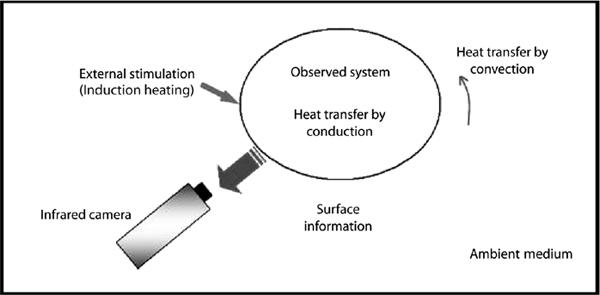4.2. Principles of the thermo-inductive method
This technique is often used to investigate and detect flaws in electrically conductive materials. The inspected piece is heated by induction and, in the presence of a flaw, the anomaly in the induced current distribution creates a concentration of power density around the flaw, which translates to a local temperature contrast to the component’s surface [GRI 05, GUP 05].
4.2.1. Installation schematic
Figure 4.1 shows the principle schematic of a thermo-inductive installation. The component to inspect is heated by induction. The temperature distribution’s inhomogeneity propagates to the material’s surface and can be detected by an infrared camera. A flaw will, therefore, be revealed by combining electromagnetic and thermal phenomena in a complementary fashion [LOU 07, RAM 09].
Figure 4.1. Technique’s principle

The advantage of this method is to increase the probability of surface flaw detection and to improve the data’s interpretation by correlating the data with two NDT methods: Eddy currents and infrared thermography [RAM 09]. It has the advantage of creating an additional perturbation, which is due to the concentration of induced currents around the flaw as shown in Figure 4.2 where a conducting plate was inspected. The flaw’s presence perturbs the lines of induced current and creates additional overheating, which will add to the ...
Get Electrothermics now with the O’Reilly learning platform.
O’Reilly members experience books, live events, courses curated by job role, and more from O’Reilly and nearly 200 top publishers.

